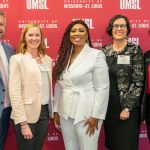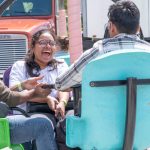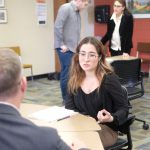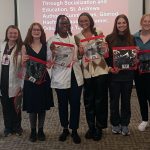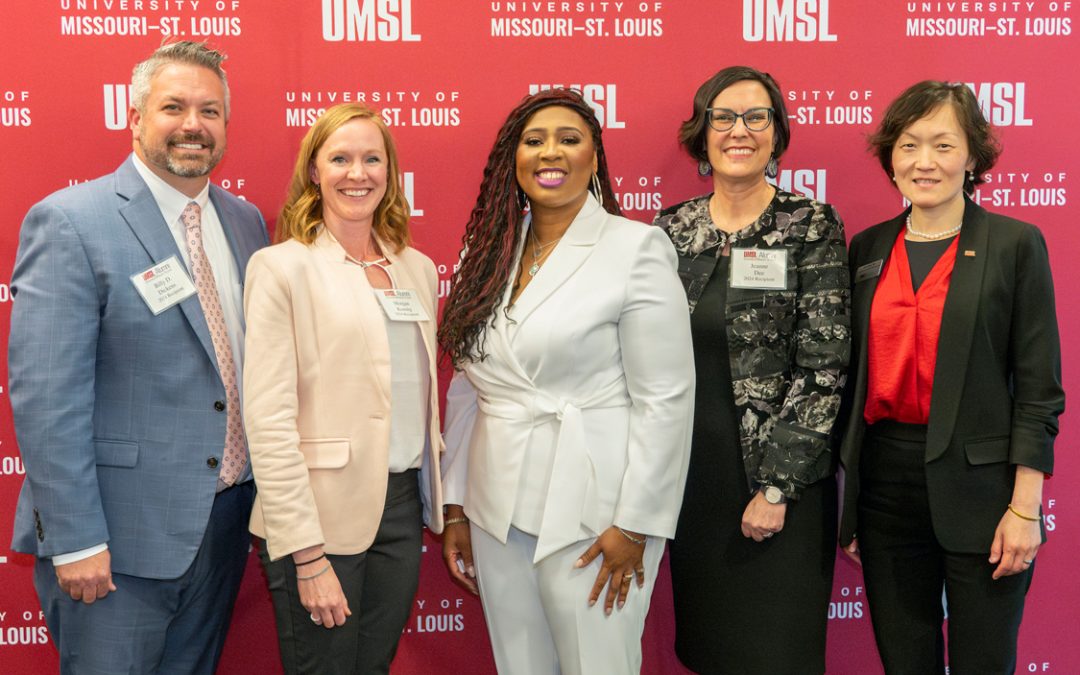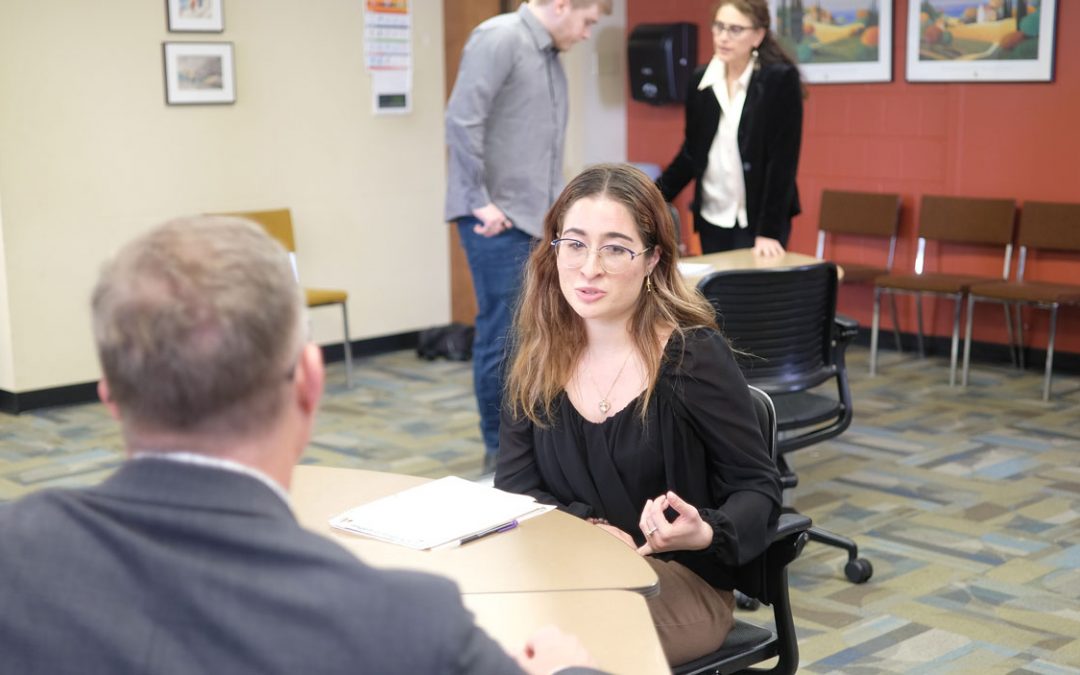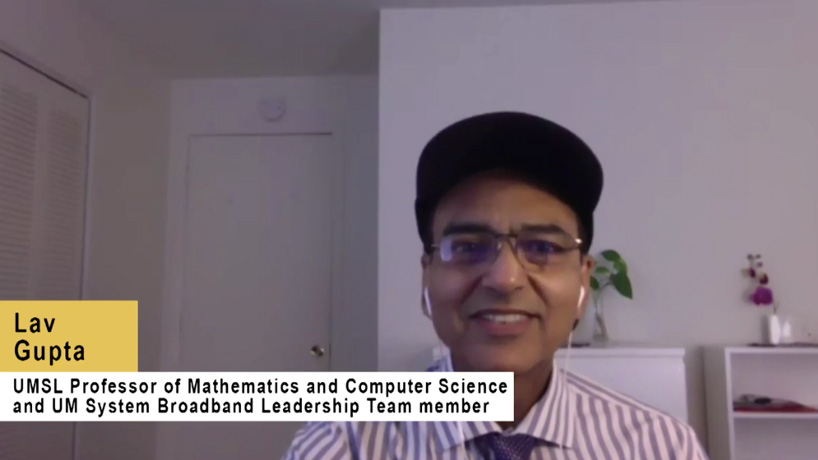
Lav Gupta, an assistant professor in the Department of Computer Science, took part in a webinar about the UM System Broadband Initiative and its efforts to bring broadband access to rural communities. (Screenshot from UM System public webinar)
The broadband revolution has made it easier than ever before to communicate with friends or engage in commerce all over the world and helped people discover the answer to almost any question in seconds with only a few keystrokes.
But not everyone in Missouri has been able to benefit from those advances. Too many communities across the state are being left behind, unable to fully realize the benefits of technological progress over the past decade.
The reason: lack of reliable, high-speed internet access.
Missouri ranks 32nd nationally in broadband access with 77.3 percent of households able to connect to wired broadband with download speeds of at least 25 Mbps and upload speeds of at least 3 Mbps, according to BroadbandNow.
Those numbers exceed 99 percent in the city of St. Louis, St. Louis County and St. Charles County. But far fewer than half the households in many rural communities have the same access.
The University of Missouri System has decided to address that with the launch of the UM System Broadband Initiative. Researchers at all four system universities – including Lav Gupta, an assistant professor in the Department of Computer Science at the University of Missouri–St. Louis – have been particularly focused in recent months on helping residents of Bollinger County find solutions to the issues keeping them from getting connected.
The UM System held a virtual workshop with community members and policy leaders from around the state on June 1 and shared a report on what they learned during a webinar last Wednesday.
Bollinger, located in Southeast Missouri and home to about 12,000 residents, has the lowest levels of broadband access in the state with only 0.8 percent of households covered.
The county’s participation in the Broadband Initiative grew out of Building Local Prosperity, a participatory community economic development planning and engagement process led by MU Extension.
“We decided that our county was stuck,” said Paula Bridges, the secretary of the Bollinger County Chamber of Commerce who represented the county in Wednesday’s webinar. “It wasn’t going forward. It wasn’t prospering. We needed to find a way to help our county. This seemed like the perfect thing.
“Through Building Local Prosperity, they were able to use extension people – Richard Proffer, in particular – to help us to focus on what our problems were and what our needs were, what our strengths are. We spent six to nine months doing that, and lots of meetings, and then we determined what our primary needs were. One of them was broadband because we recognize that our county is really not connected in any way, and it’s affecting us in all ways.”
Students have a more difficult time accessing educational materials, a problem heightened by the COVID-19 pandemic. Business owners don’t have access to the latest competitive practices. Residents can’t access telehealth services. Ultimately, it can be a barrier for people wanting to locate to that community.
The workshop considered interconnected questions about how to engage community stakeholders in broadband access and adoption initiatives, what broadband systems would best serve the community’s needs, what legal structures and business models are best suited to finance and operate broadband in the community and how broadband adoption could be promoted among residents.
Gupta had extensive experience working in the telecommunications and Internet industry, including deploying and teaching about broadband, in his native India before earning his PhD in computer science and engineering from Washington University in St. Louis. He worked with Kent Shannon, a field specialist in agricultural engineering with MU Extension, to lead two sessions about broadband infrastructure during the June 1 workshop.
“It was a delight to see participants so varied in their vocation and experience and yet very well informed and knowledgeable about this subject,” Gupta said. “There was a cautious confidence as they spoke about the necessity of the gigabit broadband and the associated fiber infrastructure, which will enable rich multimedia, interactive applications of the future.”
The remaining challenge is figuring out how to do it affordably given the topography of Bollinger County and the distribution of households and business within it.
Running miles and miles of fiber optic cable across the county’s hilly terrain is an expensive proposition, particularly if it means burying it in the rocky soil.
Using 5G technology delivered through cellular towers is even more cost prohibitive because of the number of towers that would need to be constructed to cover the whole county.
Gupta said that Bollinger and similarly placed counties are going to need a mix of technologies – with fiber taken as deep as possible into the network and covering the last part with technologies like xDSL on copper-pairs, cable broadband and point-to-point/multi-point wireless – to bring broadband access to the county in the most cost-effective way.
Residents recognize that and are ready to begin moving forward with how to do it.
Gupta is glad to be part of the project.
“I have done this kind of a project before for rural areas, and it’s something very satisfying to do and write about in whatever way you can get involved because people are so thankful after this happens,” Gupta said. “It changes the life of the community in so many tangible and intangible ways.”
The work with Bollinger is meant to become a model for other rural communities to follow to bridge the gap in broadband access.
To further that end, the UM System has unveiled the Missouri Broadband Resource Rail, a one-stop shop for information about and resources about how to bring broadband to local communities. Rob Williams, director of SourceLink, and Sam Tennant, CARES project support coordinator at MU Extension, led a demonstration of the website during last week’s webinar.
“There’s some pretty great opportunities ahead,” said Marc McCarty, an adjunct professor of law at the University of Missouri–Kansas City who is leading the UM System’s Broadband Initiative. “There are a lot of communities in the state that want to bring broadband and the applications that use it to their communities to better the health, the economic and social welfare and the educational opportunities for their community.”
To read the report from the June 1 workshop, click here.
To watch the video of last week’s webinar, click here.
The visit the Missouri Broadband Resource Rail, click here.


